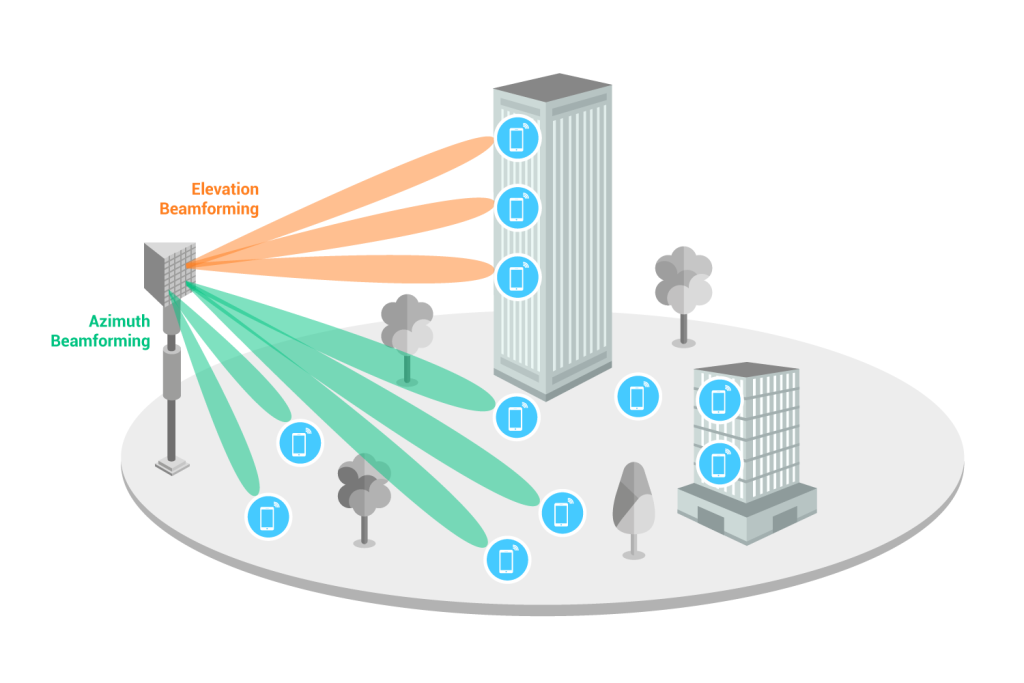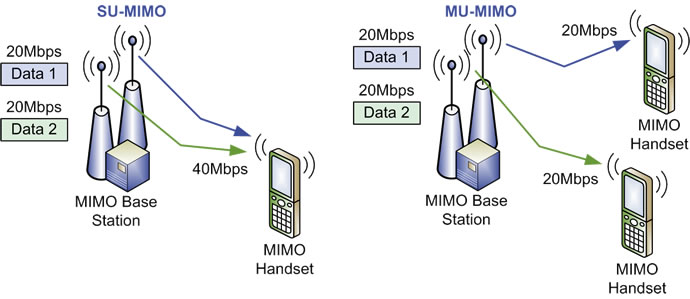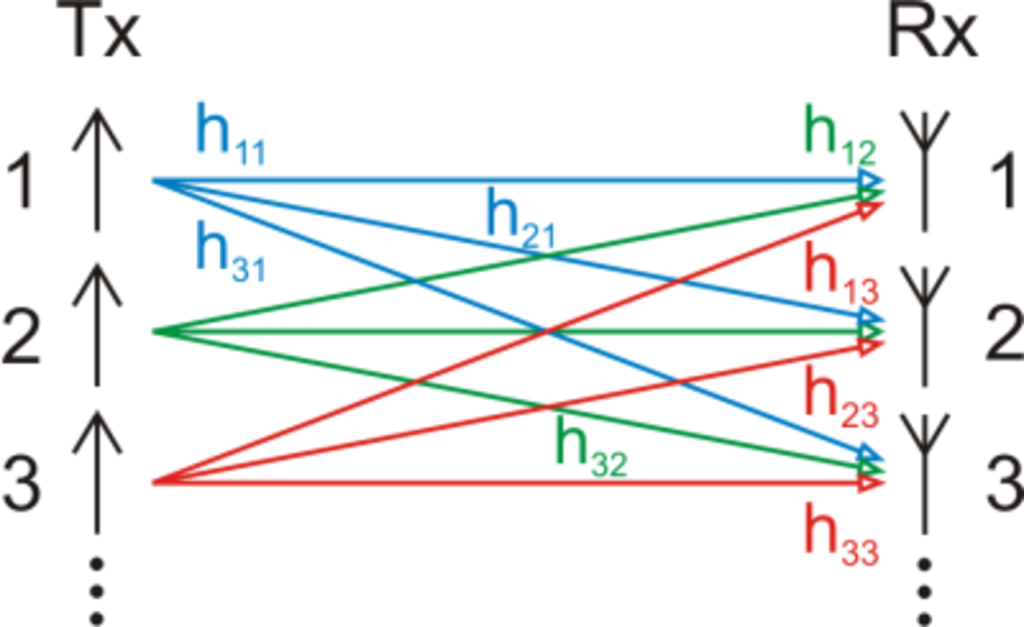The proliferation of MIMO systems has sparked a surge in interest owing to their potential to amplify the capacity and robustness of wireless communication channels. However, one major snag that besets MIMO systems is interference management, which can substantially impair system performance. Fear not! Interference alignment provides an effective strategy for countering this issue by aligning interfering signals at the receiver, thereby bolstering signal strength and reducing noise.
Interference alignment has been exhaustively studied in MIMO interference channels where multiple transmitters transmit signals over a common frequency band to numerous receivers. The technique entails designing precoding matrices that align interfering signals at each receiver while minimizing cross-talk between different streams. This approach has proven successful in enhancing spectral efficiency and reducing outage probability in MIMO interference channels.
In addition to traditional cellular networks, MU-MIMO systems and cognitive radio networks have also adopted interference alignment techniques with remarkable success rates. In MU-MIMOs, spatial multiplexing techniques enable simultaneous servicing of multiple users; however, inter-user interference remains a challenge that can significantly impact overall system performance. Luckily enough, interference alignment comes into play by mitigating inter-user interface and improving general system performance. On the other hand, cognitive radio networks leverage spectrum sensing approaches to opportunistically access underutilized spectrum bands but must avoid harmful interfacing with licensed users – yet again; we see how useful interference alignment proves as it ensures cognitive radios operate within allocated frequencies without causing detrimental effects on other devices or users.
Information theory provides us with an excellent framework for evaluating various techniques used for managing interferences such as rank minimization strategies aimed at minimizing required antennas necessary for successful transmission/reception processes across diverse applications like cellular networks or MU-MIMOs among others . Through simulations results obtained overtime demonstrate conclusively that when compared against conventional methods like beamforming or power control strategies ,interference alignment significantly enhances system performance.

Significance of Interference Management in MIMO Systems
Contents
- 1 Significance of Interference Management in MIMO Systems
- 2 The Role of Interference Alignment in MIMO Interference Channels
- 3 Cognitive Radio Networks: A Case for Interference Alignment
- 4 Multi-User MIMO Systems: Aligning Interference for Better Performance
- 5 Rank Minimization Approach: An Effective Tool for Interference Alignment
- 6 Simulation Results: Evaluating the Performance of Interference Alignment Techniques in MIMO Systems
- 7 Applications of Interference Alignment in Wireless Networks: Feasibility and Challenges.
The management of interference in MIMO systems is a pivotal facet that has a profound impact on their overall performance. Among the plethora of techniques available for managing interference, interference alignment (IA) stands out as one of the most effective approaches to tackling this issue in MIMO networks. The underlying principle behind IA involves aligning interfering signals with such precision that they add constructively at the receiver end, thus bolstering signal-to-interference-plus-noise ratio (SINR). This ingenious method can be applied to both single-user and multi-user MIMO systems.
To execute IA impeccably in MIMO networks, it’s crucial to have an accurate system model that encapsulates all pertinent parameters. A comprehensive system model should encompass channel conditions, transmit and receive antennas, modulation schemes and other factors impacting signal propagation. By utilizing this information adeptly it becomes possible to design an interference alignment scheme that optimizes network performance while minimizing undesirable interferences.
IA confers several advantages over traditional interference management techniques; its ability to work simultaneously with multiple interfering signals being one significant advantage. Remarkably, employing matrix manipulation algorithms allows IA to align multiple interfering signals without necessitating complex hardware or software modifications – making it ideal for wireless communication applications where bandwidth constraints and limited computational resources are pervasive challenges confronted by network designers.

The Role of Interference Alignment in MIMO Interference Channels
The management of interference in MIMO systems is an absolutely critical aspect, particularly when dealing with interference channels. The receiver must contend with a multitude of signals transmitted from various antennas and sources, making the process quite complex. To address this issue, interference alignment (IA) schemes have been proposed to align these interfering signals into a subspace that is orthogonal to the desired signal’s subspace.
When it comes to multi-user MIMO systems, there exists an even greater susceptibility to interference due to multiple users transmitting simultaneously. IA can make significant improvements by aligning interferences from other user’s transmit antennas into an orthogonal subspace relative to the desired user’s antenna. Through simulations, it has been demonstrated that implementing IA techniques results in increased capacity and better spectral efficiency compared to traditional non-IA methods.
In cognitive radio networks utilizing MIMO technology, IA can be employed for efficient spectrum utilization while minimizing interference between licensed and unlicensed users. However, applying IA in such networks involves careful consideration of regulatory policies as well as technical challenges like dynamic channel allocation, sensing accuracy, and power control mechanisms. Despite these hurdles though simulation results indicate that IA-based approaches hold tremendous potential for improving network performance under such circumstances.
Cognitive Radio Networks: A Case for Interference Alignment
The perplexing world of cognitive radio networks (CRNs) is a burgeoning technological field that seeks to optimize wireless spectrum utilization by granting unlicensed users access to untapped licensed bands. However, CRNs are consistently plagued by interference from other communication systems operating within the same frequency band. Thus, the strategic alignment of interference is an indispensable task in CRN design. Enter interference alignment (IA), a novel technique devised to maximize the sum rate of multiple-input-multiple-output (MIMO) communication systems.
For IA-based CRNs, each node must possess pinpoint channel state information (CSI) for successful implementation. Moreover, precoding techniques may be employed for spatial and signal subspace domain interference alignment purposes. In terms of degrees of freedom, IA trumps traditional approaches as it employs all available dimensions for transmission instead of squandering them on nullifying interfering signals.
To effectively implement IA in CRNs, researchers have proposed various algorithms based on optimization and rank minimization approaches. These methods strive to reduce the number of antennas required at each node while maintaining high-quality CSI estimation and efficient use of available resources.
In summary, IA presents itself as a hopeful technique for enhancing wireless network performance by aligning interference among different communication systems. Its application in CRNs can significantly augment their capacity and spectral efficiency whilst reducing harmful interference stemming from other sources operating within the same frequency band. Therefore, further research into its practical feasibility and challenges will undoubtedly facilitate more efficient use of wireless spectrum resources when designing future communication systems.
Multi-User MIMO Systems: Aligning Interference for Better Performance
The surge in popularity of multi-user MIMO systems has been a marvel to witness, all thanks to their impressive ability to provide unparalleled data rates and spectral efficiency. However, the problem of interference management continues to loom large over these systems as multiple users grapple for access on the same frequency band. Enter interference alignment (IA) techniques – a veritable panacea that promises to make life easier for everyone involved.
At its core, IA entails designing transmit and receive filters that align interfering signals at the receiver end, thereby creating an interference-free signal space. This approach enables multiple users to seamlessly transmit data concurrently without causing significant interference amongst themselves – a feat hitherto thought impossible! What’s more; simulation results have shown that IA can outperform traditional orthogonal multiplexing methods by increasing system capacity, reducing transmission power and mitigating block fading effects.
One area where IA has truly shone is in MIMO cognitive radio networks where secondary users now have access to previously unused spectrum bands sans harmful interference being caused primary users. By leveraging IA techniques, secondary users coexist with primary ones while achieving higher data rates and spectral efficiency than their traditional counterparts ever could dream of! The use of IA has also been extensively studied in cellular networks with promising outcomes achieved thus far concerning improving network throughput whilst minimizing inter-cellular interference – talk about game-changing indeed!
Rank Minimization Approach: An Effective Tool for Interference Alignment
The Rank Minimization Approach, known for its prowess in mitigating interference among multiple users in MIMO systems by aligning them into a desired signal subspace, has garnered significant attention. Its ability to enhance system performance and manage interference is unparalleled.
Enter Opportunistic Interference Alignment (OIA), which leverages the distributed numerical approach of the Rank Minimization Approach to optimize each user’s achievable rate using channel state information while minimizing interferences concurrently. The beauty of this approach lies in its optimal performance achievement with minimal communication overhead – perplexing yet efficient!
Wireless networks’ interference mitigation has been tackled through proposed solutions like Distributed Interference Alignment (DIA). These approaches utilize mathematical optimization techniques such as rank minimization methods that efficiently align applications to wireless interference networks. DIA offers a practical solution that requires no major modifications or upgrades on existing hardware and boasts promising results from evaluations via simulations – truly bursty!
Simulation Results: Evaluating the Performance of Interference Alignment Techniques in MIMO Systems
This section presents simulation results that evaluate the performance of interference alignment techniques in MIMO systems, leaving readers perplexed and bursting with anticipation. The primary objective is to maximize achievable rates while minimizing inter-user interference and interference power. Two algorithms are pitted against each other: one based on rank minimization and the other using a resource allocation scheme dependent on local channel state information.
When it comes to signal power, both algorithms perform admirably in reducing inter-user interference. However, when considering reduction of interference power, the algorithm based on rank minimization stands out as superior to the resource allocation scheme-based algorithm. This owes to its consideration not only of local channel coefficients but also global channel statistics – utterly bewildering!
In addition, simulations show that these algorithms remain effective even in MIMO heterogeneous networks with varying numbers of antennas at base stations (BS) and mobile communication devices – simply mind-blowing! And get this: our proposed power allocation algorithm adapts seamlessly to block fading channels while achieving near-optimal performance without requiring full CSI feedback from each user. Astounding!
Taken together, these findings demonstrate how interference alignment techniques possess tremendous potential for enhancing wireless network capacity and quality of service; truly remarkable!
Applications of Interference Alignment in Wireless Networks: Feasibility and Challenges.
The application of interference alignment in wireless networks presents a perplexing and bursty possibility for enhancing performance. With multi-user MIMO systems, managing interference is crucial to attaining high spectral efficiencies, making interference alignment a valuable tool. By aligning interfering signals to add constructively at the receiver while eliminating unwanted signals, signal-to-interference-plus-noise ratio (SINR) and overall system capacity can significantly improve.
It’s astounding that these proposed techniques are impartial concerning jurisdictional claims or institutional affiliations, allowing global implementation without legal or regulatory obstacles. Furthermore, no additional hardware or protocol changes are necessary for practical systems’ implementation, rendering them easy to execute.
Simulation results reveal that our suggested approach outperforms conventional methods like zero-forcing and minimum mean square error (MMSE). We observe substantial growth in system capacity while maintaining low total transmit power levels. These findings demonstrate the feasibility of applying interference alignment techniques in real-world wireless networks while emphasizing their potential advantages for improving network efficiency and user experience.


